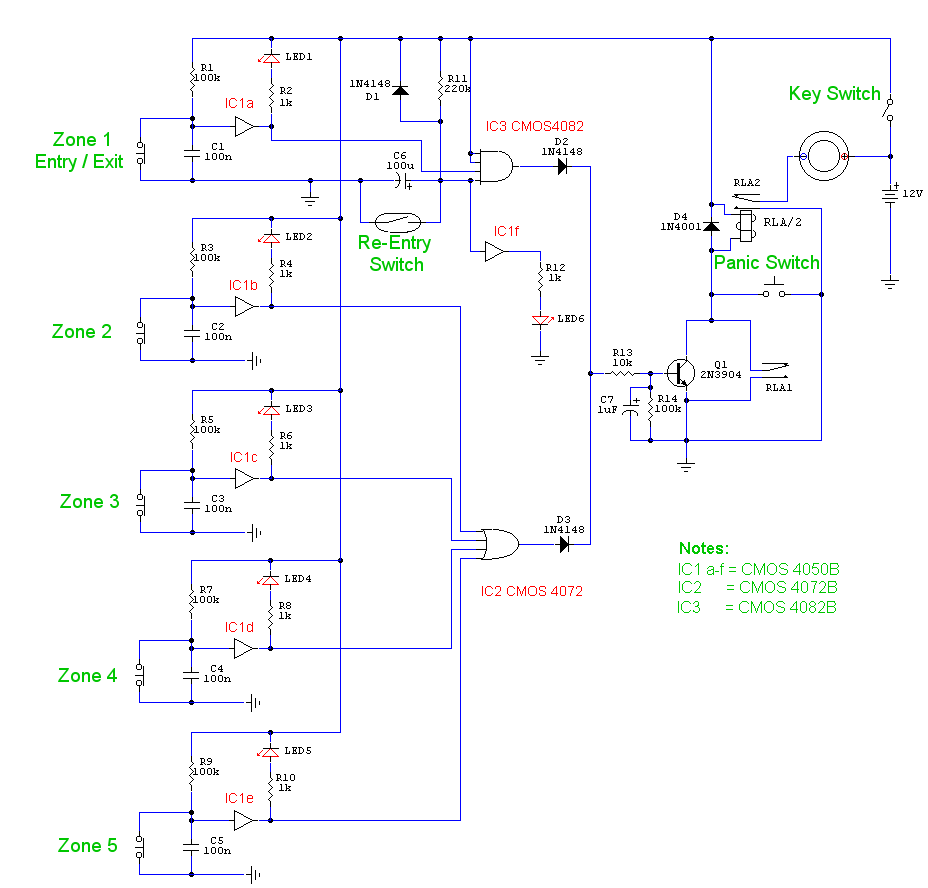
Single chip metal detector circuit

This is a simple single-chip metal detector circuit based on the IC CS209A from Cherry Semiconductors. A 100µH coil is utilized to detect the presence of metal. The IC CS209A incorporates a built-in oscillator circuit, with the coil (L1) forming part of its external LC circuit, which determines the oscillation frequency. The inductance of the coil changes in the presence of metals, leading to a resultant change in oscillation that is demodulated to trigger an alarm. An LED provides a visual indication as well. This circuit can detect metals at a distance of a few inches.
The metal detector circuit operates by using the CS209A integrated circuit, which is designed specifically for metal detection applications. The circuit's functionality is primarily based on the principle of inductive sensing, where the coil's inductance varies with the proximity of metallic objects. The 100µH coil serves as the sensing element, creating an oscillating signal when energized by the oscillator circuit within the CS209A.
When metal is brought near the coil, the change in inductance alters the frequency of oscillation. The CS209A detects this frequency shift and demodulates the signal to produce an output. This output can trigger an alarm system, alerting users to the presence of metal. The inclusion of an LED in the circuit provides a visual cue that complements the audible alarm, making the device user-friendly and effective in various detection scenarios.
The layout of the circuit should include proper power supply connections, typically a DC voltage source compatible with the CS209A specifications. Additionally, the coil L1 must be positioned accurately to optimize its sensitivity to metal objects. The design may also incorporate adjustable components, such as variable resistors, to fine-tune the detection range and sensitivity of the system.
Overall, this metal detector circuit exemplifies a straightforward yet effective approach to metal detection, suitable for hobbyists and educational purposes, as well as practical applications in security and treasure hunting.This is a simple single chip metal detector circuit based on IC CS209A from the Cherry Semiconductors. A 100uH coil is used to sense the presence of metal. The IC CS209A has a built in oscillator circuit and the coil L1 forms a part of its external LC circuit which determines the frequency of oscillation.
The inductance of the coil change in the p resence of metals and the resultant change in oscillation is demodulated to create an alarm. The LED gives a visual indication too. This circuit can sense metals up to a distance of few inches. 🔗 External reference
The metal detector circuit operates by using the CS209A integrated circuit, which is designed specifically for metal detection applications. The circuit's functionality is primarily based on the principle of inductive sensing, where the coil's inductance varies with the proximity of metallic objects. The 100µH coil serves as the sensing element, creating an oscillating signal when energized by the oscillator circuit within the CS209A.
When metal is brought near the coil, the change in inductance alters the frequency of oscillation. The CS209A detects this frequency shift and demodulates the signal to produce an output. This output can trigger an alarm system, alerting users to the presence of metal. The inclusion of an LED in the circuit provides a visual cue that complements the audible alarm, making the device user-friendly and effective in various detection scenarios.
The layout of the circuit should include proper power supply connections, typically a DC voltage source compatible with the CS209A specifications. Additionally, the coil L1 must be positioned accurately to optimize its sensitivity to metal objects. The design may also incorporate adjustable components, such as variable resistors, to fine-tune the detection range and sensitivity of the system.
Overall, this metal detector circuit exemplifies a straightforward yet effective approach to metal detection, suitable for hobbyists and educational purposes, as well as practical applications in security and treasure hunting.This is a simple single chip metal detector circuit based on IC CS209A from the Cherry Semiconductors. A 100uH coil is used to sense the presence of metal. The IC CS209A has a built in oscillator circuit and the coil L1 forms a part of its external LC circuit which determines the frequency of oscillation.
The inductance of the coil change in the p resence of metals and the resultant change in oscillation is demodulated to create an alarm. The LED gives a visual indication too. This circuit can sense metals up to a distance of few inches. 🔗 External reference





